Gobekli Tepe and Dogon Symbols
of the Alien Nummo
(Updated June 2023)
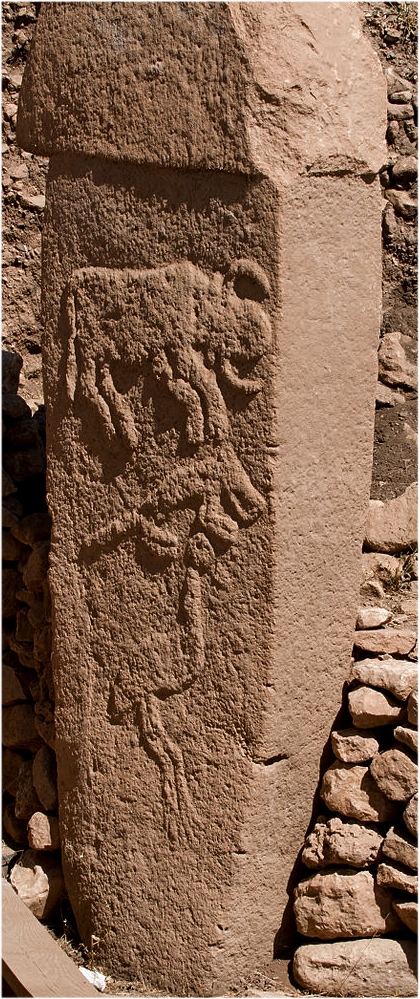 Low Relief, Gobekli Tepe by Teomancimithttp://en.wikipedia.org/wiki/File: Gobekli_Tepe_2.jpg |
The symbols found at the 12,000 year old temple at Gobekli Tepe are the same symbols that were known to the Dogon people of Mali, Africa.
My research in Day of the Fish reveals the Dogon religion to be the oldest religion in the world and these symbols from Gobekli Tepe help to reaffirm that conclusion. This article will explain what some of those symbols meant to the Dogon people and how they would have been interpreted by those who carved them 12,000 years ago.
The serpent is a key symbol that appears at Gobekli Tepe. When the serpent appeared on Dogon artefacts, it not only symbolized immortality but represented the Nummo and the Eight Nummo Ancestors. Because of their long fish tails, when the Nummo moved on land they looked like serpents. When Ogotemmêli was describing his religion to Griaule, he most often referred to the alien Nummo, as "the Serpent."Shannon Dorey, Day of the Fish pp.20-34
According to the Dogon people, the alien Nummo and the Eight Ancestors, who were part Nummo and part human, were amphibians but they had fish tails and spent most of their time in water. A fish tailed creature is also carved onto one of the stones at Gobekli Tepe.
Even though they were hermaphrodites, the Nummo were identified with the sacred feminine and were considered the mothers of humanity. The cow and sun were symbols of the Nummo, and on the stone above from Gobekli Tepe, we see a cow with possibly a sun between its horns. In the Dogon language the sun's name, nay, had the same root as "mother," na, and "cow," nã.
Cow symbolism is also found in Egyptian mythology where the goddess Isis was sometimes known as the "cow of heaven" and depicted on some ancient artefacts as a woman with horns (shown below) and on others, as a cow with a sun between her horns. In other instances, Isis was shown as a serpent with a crown or casque on top of her head. I believe that these descriptions of Isis identify her with the alien Nummo as they were described by the Dogon people.Shannon Dorey, Day of the Fish p. 41
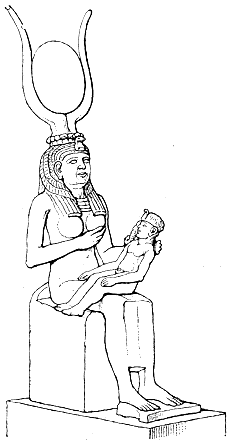 Sun between Isis' HornsBerlin Museum, 1888 Meyers Konversations lexikon. Copied from http://de.wikipedia.org the public domain |
Isis is shown here with her child Horus, an image that historians believe was later used as the basis for the Christian Madonna image. The Nummo were the mothers of the Earth.Shannon Dorey, Day of the Fish p.28
The Nummo were shapeshifters and there are many varied descriptions that relate to them. They were creatures of the sea, the land and the air. The Nummo had a horn or casque on their head and for this reason horned land animals including antelopes, deers, gazelles and lizards, such as chameleons, symbolized the Nummo. These images and many others associated with the Nummo appear at Gobekli Tepe.
Because there was tubing that curled around the top of the Nummo spaceship in the shape of ram's horns, the Nummo were also known as "Celestial Rams" while flying in their ships. A ram head also appears at Gobekli Tepe.Shannon Dorey, The Master (Mistress) of Speech p. 23
The Nummo were also associated with birds in general and were said to have gizzards. It is believed that dinosaurs had gizzards and that birds are considered to be a type of dinosaur. In fact they are the only dinosaur still surviving to the present day. This may give us some indication of how long the Nummo have been associated with the Earth.Shannon Dorey, Day of the Fish pp.20-34
Because they had fish tails and were primarily aquatic beings, the Nummo were identified with water birds in some cultures. Water birds appear frequently at Gobekli Tepe. In her research on Old Europe, archeologist Marija Gimbutas made a connection between the ram, which as I referred to earlier was a symbol of the Nummo in their spaceships, and the Bird Goddess.
My research in Day of the Fish indicates that the Goddess religion of old Europe was the same religion known to the Dogon people. The Nummo were hermaphrodites, with breasts and penis, but identified with the sacred feminine. Gimbutas writes:
Bird's heads with ram's horns appear on bird-shaped vases of the Early Helladic .I period [2650-2200/2150 BCE]. These beautifully shaped and burnished vases continue to be misleadingly called `sauceboats.' Their waterbird shape is obvious, and the addition of ram's horns to some of their heads suggests their important role in the cult of the Goddess. There are also winged rams, such portrayals appear on Late Minoan seals from Kato Zakros in Crete. The intimate link between the ram and the Bird Goddess is clear. The ram-headed serpent is the most expressive and typical of the Celtic cult animals. (Ross 1967:344).
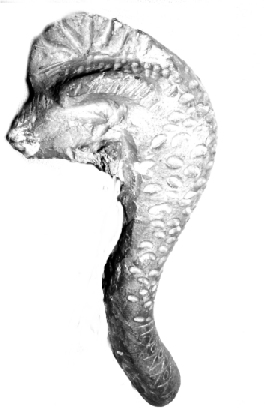 Ram Headed Serpent, CarlisleRoman Carlisle ©Robert Hill |
A Celtic ram-headed serpent taken from excavations at Roman Carlisle in England appears in Day of the Fish and is shown here. I came across this serpent at Tullie House Museum in Carlisle on a trip to England and Scotland in 2005, and I was surprised to see how closely it was associated with the Dogon religion. A relief of a ram's head with spiralling horns and an owl's beak is also shown on one of the walls of a rock-cut tomb at Perfugas, Sardinia, dated to around the 4th millennium BCE.
The owl is also found at Gobekli Tepe. Ogotemmêli described the second generation of Nummo/human offspring, of whom the Mistress of Speech was one, as having "wide-open eyes." The Mistress of Speech, who was also known as the Seventh Ancestor, was the saviour in the Dogon religion.Shannon Dorey, The Master of Speech p.57 Because owl madonnas appear in some cultures, I associate the owl with the Mistress of Speech, who the Dogon said gave birth to Lébé, the mother of all humans living today.Shannon Dorey, Day of the Fish p.53
Although the Nummo were associated with the night, because they primarily moved around at night, they were identified with the morning in some cultures. This is because wader birds such as cranes, ibises and herons stood in water at the seashore and were the first to welcome the dawn as it came up from the East.
Among the Egyptians, the Bennu bird, which was a type of heron, was regarded as the emblem of regeneration and signified the rearising of the sun (a symbol of the Nummo) and the return of Osiris to the light.Howard Bayley, Lost Language of Symbolism, p. 68 The Dogon religion is focused on helping humans find their way back to truth and immortality. The crane appears on the stone above from Gobekli Tepe, which is an important symbol in various North American Indigenous cultures like the Ojibwa (Ojibwe). William Warren, of Ojibwe and European descent, described how the great spirit once made a bird, and sent it from the skies to make its abode on Earth. "The ancestral crane soared over the epicenter of the Ojibwa world."Shannon Dorey, Day of the Fish p. 41 Other wader birds appear on some of the other stones found there.
According to Egyptian mythology, the sun god Ra grew up every morning as a lotus from the waters of Nun. When the lotus' petals unfurled, Ra emerged from them and was identified as the Bennu bird perched on the Benben stone. The Benben stone was said to be a golden obelisk that caught the sun's first rays. (An obelisk is a square shaft of stone with a pyramidal top. An example is the Washington Monument.) Every evening when Ra returned, he was folded back inside the lotus blossom.Dorey, The Nummo p. 48-49
According to the Dogon, the Nummo spaceship was divided into four parts and was "like the closed corolla of the blossom of a water lily." It was said to have unfolded in a horizontal plane like a flower that opens up and whose petals are supported by the axis of the world that emerged from it. Because the lotus is similar to the water lily, the two flowers are often used interchangeably. The Egyptians described the Bennu bird's (Ra) dwelling as a lotus in the same way the Dogon described the Nummo spaceship as being like a lily.Dorey, The Nummo p. 48-49
In the Dogon religion, the Jackal or Pale Fox as he was also known, was considered the first human. The Jackal, who was male, symbolized death or mortality in humanity. He was the evil in the religion and associated with our lost immortality.Shannon Dorey, The Master of Speech pp.18-20 The dog is a common symbol that appears at Gobekli Tepe, which is shown on the stone at the beginning of the article.
Animals that symbolized the Jackal in the Dogon religion were the dog, hyena, wolf, goat, bull and alligator, most of which appear at Gobekli Tepe. The Jackal was associated with a chicken's egg and was symbolized by a rooster. To my knowledge, no rooster appears at Gobekli Tepe. He was also symbolized by the moon and the colour white.
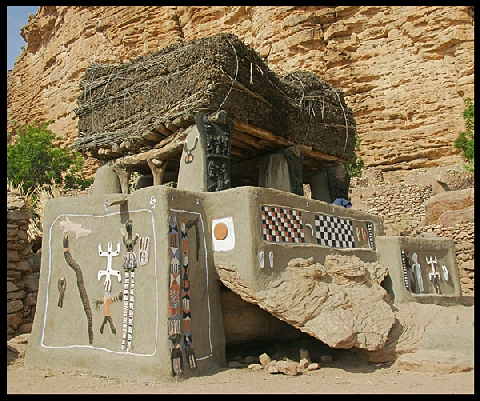 Dogon architecture in Mali. Photo by Dario MenasceDario Menasce - I.N.F.N. Milano http://hal9000. mi.infn.it/~menasce |
This Dogon mud building with religious symbols and thatched roof, shows the Serpent (left) as it appeared in the Dogon village. Another important figure that appears on this building is the barankamaza dullogu, far right and left. This insect also appears at Gobekli Tepe. According to the Dogon, this was a water insect that was sent to counteract the deeds caused by the Jackal.Dorey, The Rose p. 103
"According to the Dogon elder Ogotemmêli, humans have two souls. A depiction of the black and white chequered blanket, shown on this Dogon dwelling, and known as the pall of the dead, symbolized this dual aspect of humanity. The white square on the pall of the dead represented consciousness and the first soul, which is associated with humanity and the Earth. The black square represented the subconscious or unconscious and the second soul, which is associated with the Nummo and their world. By symbolizing the two souls, the black and white squares display our inner duality.
The Dogon believed that once humans regain their androgyny, they will also regain their immortality. The blanket was therefore a symbol of life and resurrection."Dorey, Day of the Fish p. 154 It was associated with the regeneration of the Jackal.
A strange H symbol with a circle in the centre of it appears at Gobekli Tepe and this symbol was known as the "House of the Fox" in the Dogon religion. An open semi circle with a circular object inside it, likewise appears at Gobekli Tepe. In the Dogon religion this symbol represented the sky containing the sun.Shannon Dorey, Day of the Fish pp. 166-169
The dog was a harbinger of death in many ancient cultures including the Celtic and Aztec. In the Dogon religion, the Jackal was symbolized by the planet VenusShannon Dorey, Day of the Fish p. 166 and the Aztec god Xolotl, depicted as a dog headed man, was "the dark personification of Venus, the evening star."http://en.wikipedia.org/wiki/Xolotl Venus plays an important role in the Dogon religion and is referred to in detail in The Rose: Dogon Star Knowledge.
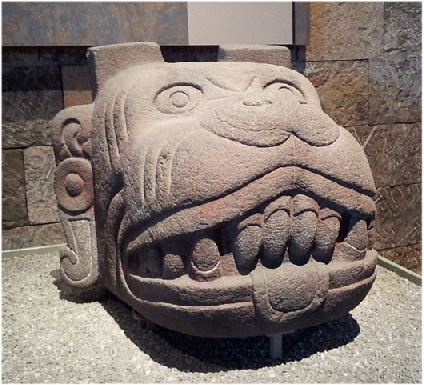 Aztec Xolotl as Beast by Adamthttp://en.wikipedia.org/wiki/ File:Xolotl_muz.jpg |
The Aztec god Xolotl was also the god of fire and of bad luck. "Xolotl was the twin of the feathered serpent Quetzalcoatl, the pair being sons of the virgin Coatlicue. The word Coatlicue is Nahuatl for 'the one with the skirt of serpents'". The Nummo were self-fertilizing hermaphrodites and because they were identified with the sacred feminine, my research reveals that they evolved into later myths of virgin goddesses.
Coatlicue is referred to variously by the epithets "Mother Goddess of the Earth, who gives birth to all celestial things", "Goddess of Fire and Fertility", "Goddess of Life, Death and Rebirth", and "Mother of the Southern Stars."http://en.wikipedia.org/wiki/Coatlicue
The Jackal's twin sister, who was also born during the same experiment and a hermaphrodite, was the good in the Dogon religion and associated with the serpent-like Nummo, which may identify her with the feathered serpent Quetzalcoatl. My research reveals that in later patriarchal cultures the male and female symbols became reversed so that the male symbol became associated with good, rather than evil.Shannon Dorey, Day of the Fish p. 10
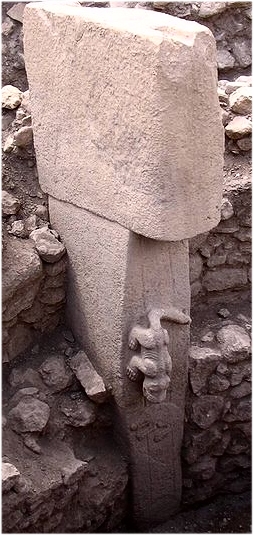 Beast from Gobekli Tepehttp://en.wikipedia.org/wiki/File: GobeklitepeHeykel.jpg |
A similar creature to Xolotl appears at Gobekli Tepe. This beast also appears on Celtic Pictish stones.
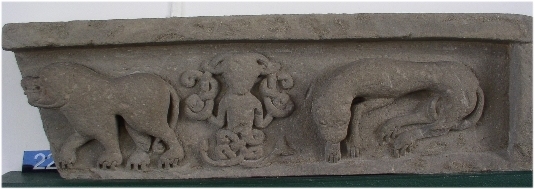 Pictish Beasts and Serpent Legged Jackal©Robert Hill |
This Celtic Pictish stone is from Meigle Museum in Scotland. In the Dogon religion, the Jackal was also described as having two serpent-like legs just like this figure on this Celtic Pictish stone. This differed from the Nummo who only had a single tail. There is also a sculpture of the Aztec Xolotl as a dog with a human face that is reminiscent of the Jackal being turned into a fox or dog.
A human statue that was found at Gobekli Tepe has no mouth. This is a very important aspect of this statue in association with the Dogon religion because it symbolizes lost speech. Round mouths, on the other hand, were positive symbols because they represented a full moon and the Nummos' return to Earth was to be accompanied by a full moon. Round mouths were generally associated with the Mistress of Speech (Seventh Ancestor), who was the saviour in Dogon mythology.Shannon Dorey, Day of the Fish p.259
The Nummo and the Eight Ancestors were symbolized by turtles and turtles likewise appear at Gobekli Tepe. The turtle's shell was a symbol of the Nummo spaceship and the sun. The turtle's upper shell represented the celestial world (the Nummos' world), and its lower shell represented the Earth. The creation of the turtle represented the sun and the Earth becoming twins. In other words, humans and the Nummo becoming twins.Shannon Dorey The Nummo pp.148-150 The Dogon also associated the turtle with the nay, which was the circumcised prepuce in men and was identified with his female soul and the sun. It represented the Nummo soul found within humans.See Shannon Dorey The Nummo p. 178
An Ostrich, a symbol associated with the Mistress of Speech, also appear on the stones at Gobekli Tepe.Shannon Dorey The Nummo p. 232 All Eight Ancestors had human upper bodies and fish-tailed lower bodies. They were all hermaphrodites and were likewise symbolized by the scorpion, which is another figure that appears at Gobekil Tepe.
Because they were hermaphrodites, the Eight Ancestors were considered twins by the Dogon people. They were all immortal like the Nummo. Twins have a mythological significance to the Dogon because of their association with androgyny. Griaule reports:
Dogon religion and Dogon philosophy both expressed a haunting sense of the original loss of twin-ness. The heavenly Powers themselves were dual, and in their earthly manifestations they constantly intervened in pairs… Actually the birth of twins is a notable event. It recalls the fabulous past when all beings came into existence in twos, symbols of the balance between the human and the divine.Shannon Dorey, The Master (Mistress) of Speech p.184
In one Dogon version of the myth of Lébé's birth, Lébé was swallowed and then regurgitated by the Mistress of Speech (Seventh Ancestor) in her serpent form. Lébé, who was the mother of humanity, was symbolized by the lion and I believe the cat may have also represented her as well. A lion and a cat appear on the statues at Gobekli Tepe.
Because Lébé was a hermaphrodite, my research reveals that she was often represented by dual lions. The Nummo were a type of catfish and in some of the Dogon drawings, whiskers were depicted on the Nummo, Lébé, and the Eight Ancestors. Lébé was also described as having a serpent tail, fish tail and in other instances was depicted as a fish.Shannon Dorey, The Rose p. 339
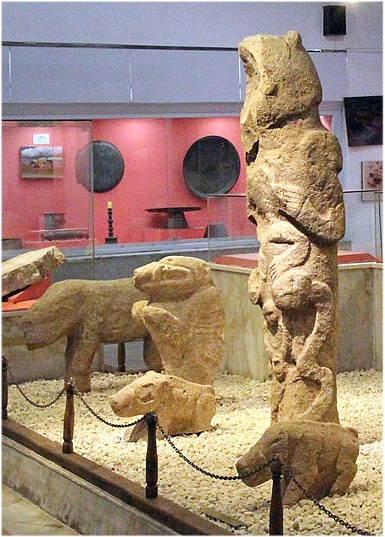 Bear Mother, Boars and Owlhttp://commons.wikimedia.org/wiki/File: UrfaMuseumG%C3%B6bekli.jpg Archäologisches Museum Sanliurfa, Südosttürkei, Stelen und Skulpturen aus Göbekli Tepe Klaus-Peter Simon |
I believe that the tall statue above from Gobekli Tepe symbolizes the birth of Lébé. This statue found in the museum at Gobekli Tepe shows dual serpents on a totem along with a large animal, most likely a bear, giving birth to a human baby. A cat or lion face appears on the left, which was a symbol of Lébé. My research has found that the Mistress of Speech (the Seventh Ancestor), who was part human and part Nummo, was symbolized by the boar, owl and the bear in Celtic and other ancient religions including Greek. The owl and boar appear in the museum beside the animal figure giving birth.
In some Dogon myths, the Mistress of Speech was sacrificed when Lébé was born and the boar was sacrificed in many Celtic myths. The bear was also sacrificed in ancient Japanese and North American Indigenous cultures. The hunt is associated with death and regenertion in the Dogon religion and the Mistress of Speech was the mistress of the hunt, which was associated with the planet Jupiter. (See Chapter 16, The Great Bear pp. 250 - 259 in Day of the Fish).
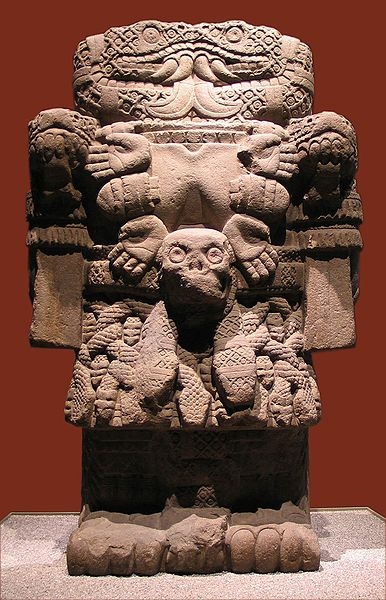 http://en.wikipedia.org/wiki/File: 20041229-Coatlicue_(Museo_Nacional_de_ Antropolog%C3%ADa)_MQ-3.jpg Statue of Coatlicue displayed in National Anthropology Museum in Mexico City. |
The statue in the museum at Gobekli Tepe also reminds me of this statue of the virgin goddess Coatlicue from Aztec mythology referred to earlier. The babies appear in the middle of the figures and there are two sets of hands on both totems. A serpent appears on the statue from Gobekli Tepe and a skirt of serpents on Coatlicue. In turn, Coatlicue is reminiscent of the Gorgon from Greek mythology, which I refer to in Day of the Fish and associate with the Mistress of Speech.
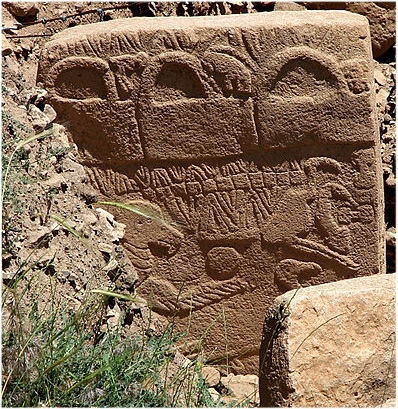 Vulture with Egg, Aquatic Birdshttp://commons.wikimedia.org/wiki/File: G%C3%B6bekli2012-18.jpg Göbekli Tepe, Siedlungshügel bei Sanliurfa, Südosttürkei, Anlage D Pfeiler 43 |
My research reveals that black birds including ravens and vultures are associated with the Nummo in various cultures including Celtic, Chinese, Persian and Maya. A vulture appears on the stone above from Gobekli Tepe with a circular symbol, which may symbolize both the sun and an egg. The scorpion referred to earlier also appears on this stone but isn't visible in this picture. These birds were considered creator deities.
A Chinese silk funeral banner found in a Han Tomb, 193-141 BCE, which I refer to in The Nummo, depicts the moon on the left and the sun on the right, which is consistent with Dogon symbolism. A black bird appears in the centre of the sun. If we relate this to Dogon mythology, it indicates that the black bird is a symbol of the Nummo. The black bird also appears in Greek mythology as a creator deity.Dorey, The Nummo p. 202
The raven is the creator of the world and bringer of daylight of the Pacific Northwest Indigenous cultures, including the Tlingit, the Haida, the Tsimshian, the BellaBella, and the Kwakiutl. The raven was also important in creation myths of the Eskimo and even today remains a significant social and religious component of Alaskan culture.Dorey, The Nummo p. 202
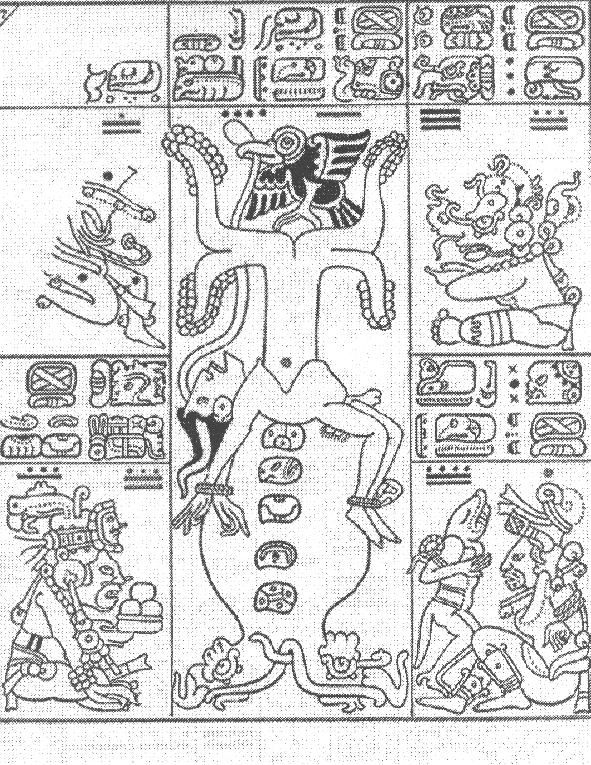 Page 3 Kingsborough and Forstemann Editionshttp://www.famsi.org/mayawriting/ codices/dresden.html |
The vulture also appears in Maya mythology. I included page 3 from the Kingsborough and Forstemann editions of the Dresden Codex above, in Day of the Fish because it shows a hermaphrodite impaled on a tree with her feet and hands tied together by a vulture. In some Dogon carvings, the Mistress of Speech appears as a human hermaphrodite with breasts and penis. In one of the Dogon stories about the Mistrees of Speech's sacrifice, her umbilical cord was planted, came to life and transformed itself into a tree known as the kilena.
It was the kilena tree that the Mistress of Speech was tied to when she was sacrificed. The Dogon said the kilena tree had the power to revive the dead. The roots of the tree spread out in three directions, and its two branches supported the Mistress of Speech's pectoral fins.Dorey, Day of the Fish pp. 321-322
Page 3 from the Kingsborough and Forstemann editions of the Mayan Dresden Codex above, shows a frog or lizard figure in the bottom right corner and a black vulture standing on top of a tree tying a hermaphrodite to it. A black navel appears on the bottom of the tree, which I believe is linked to the Dogon story of the Mistress of Speech's umbilical cord being planted and transforming itself into the kilena tree.
On this drawing, the tree grows up through the navel of the hermaphrodite lying on her back on top of the omphalos shaped object. Her penis and breasts are visible. Stone like images also appear on the tree's branches which may be associated with the yayaga plant that the Dogon said grew on the kilena tree in the same way that mistletoe grows on an oak. I believe that it is because of this association that mistletoe was identified with regeneration in many ancient cultures.
The frog is an important symbol in this picture because frogs are amphibians like the Nummo. Frogs appear throughout the Neolithic and are referred to in detail in Day of the Fish. I believe that stories about the Eight Ancestors also appear in Egyptian myths in the tales of the "Ogdoad of Khmunu (Hermopolis), four frog gods and four snake goddesses of chaos."Dorey, Day of the Fish p. 44
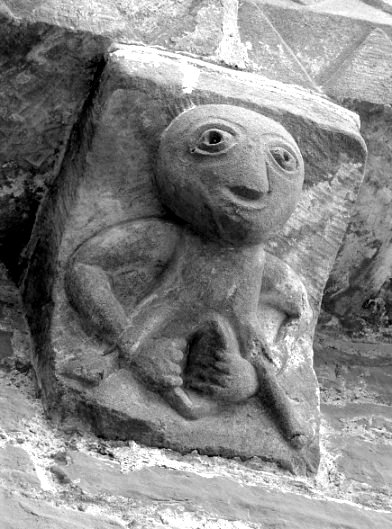 12th-century AD Sheela Na gig Dorey, Day of the Fish p. 59 |
This is a carving of a 12th-century Sheela Na gig from St. Mary's and St. David's Church, Kilpeck, Herefordshire, England. According to Gimbutas, the Sheela Na gig, a figure which has been found incorporated into old churches in medieval Ireland and England, was none other than the ancient frog or toad goddess, the birth giver and regeneratrix inherited from the Neolithic. A Sheela Na gig image is found in a drawing carved into a stone slab on the floor of the Lowenpfeilergebaude at Gobekli Tepe. The naked woman is depicted in a sitting position with straddled legs and two standing pillars with lions sculpted in relief protect the drawing.http://medusacoils.blogspot.ca/ 2009/03/worlds-first-Sheela -na-gig-at-worlds.html Lydia Ruyle As I referred to earlier, the lion was a symbol of Lébé in the Dogon religion, and because she was a hermaphrodite, she was usually portrayed as two lions, which would associate her with these two pillars. Lébé was considered the mother of all humans living today.
Gimbutas refers to the significance of the frog and toad image to Goddess mythology:
The frog and toad image, along with the frog-shaped woman displaying her vulva, appears across a wide time span, not only during the European and Anatolian Neolithic but in the Near East, China, and the Americas. Several closely related frog deity images in Egypt and the Near East help explain the function of this goddess. Egyptians revered the frog as Heket, primordial mother of all existence. In the early predynastic period (around 3100 BCE), she was portrayed as a woman with a frog head, or as a frog or toad impersonating the goddess. "Frog" was her hieroglyphic sign. Heket controlled fecundity and regeneration after death.Dorey, Day of the Fish p. 59
I believe the opening in the hermaphrodite's navel from the codex is connected to the oval opening on the bear statue above found in the museum at Gobekli Tepe revealing the head of a baby.
The frog regenetrix Sheela Na gig holding open her vulva (shown above) and the Fish Goddess of Lepenski, holding open her vulva were written about in Day of the Fish and associated with regeneration.
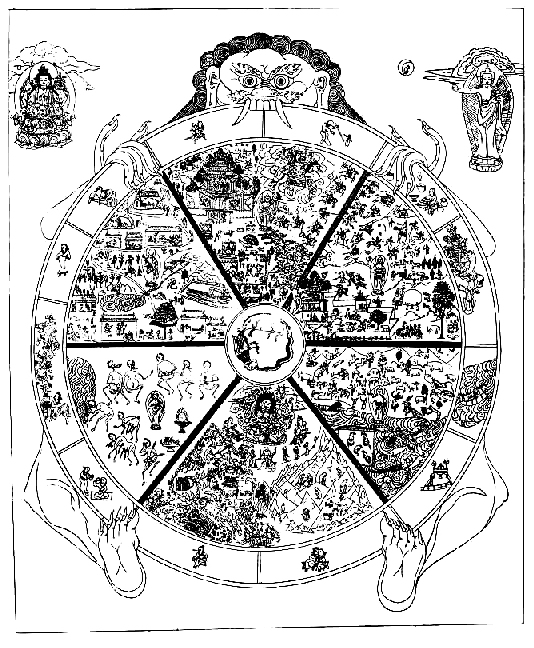 Wheel of Life Tibetan BuddhismDorey, Day of the Fish pp. 207-208 |
These images are also linked to the earlier picture of the Aztec goddess Coatlicue and this picture of a Gorgon-like figure holding the Wheel of Life, which comes from Tibetan Buddhism, and is also referred to in Day of the Fish. Notice the serpent, boar and rooster found in the centre of the Wheel of Life. These figures represent the three different figures in the Dogon religion. The boar is a sacrificial figure and often appears in association with the sacrifice of the male Jackal. The Master (Mistress) of Speech was also sacrificed, and in this instance, the boar is being identified with her. The serpent symbolizes the Nummo, and the rooster, the Jackal.Dorey, Day of the Fish pp. 207-208
This Gorgon figure holds the wheel in the same fashion that the frog regenetrix Sheela Na gig, the Aztec goddess Coatlicue and the animal figure at Gobekli Tepe position their hands beside their navels or vulvas. In the bottom left section of the Wheel of Life, crouched pregnant figures hold open their navels. I find these crouched figures very strange and in some instances remind me of ants, which was a symbol of Mother Earth and the first humans in the Dogon religion. A ant image also appears at Gobekli Tepe.Dorey, Day of the Fish pp. 207-208
On this image of the Wheel of Life, a bull, a Jackal figure, is shown on the top left and a cow, symbolizing the Nummo, is on the top right. Everything associated with the Nummo always appeared on the right side of the Dogon sanctuary and everything symbolizing humans and the Jackal appeared on the left.Dorey, Day of the Fish pp. 207-208
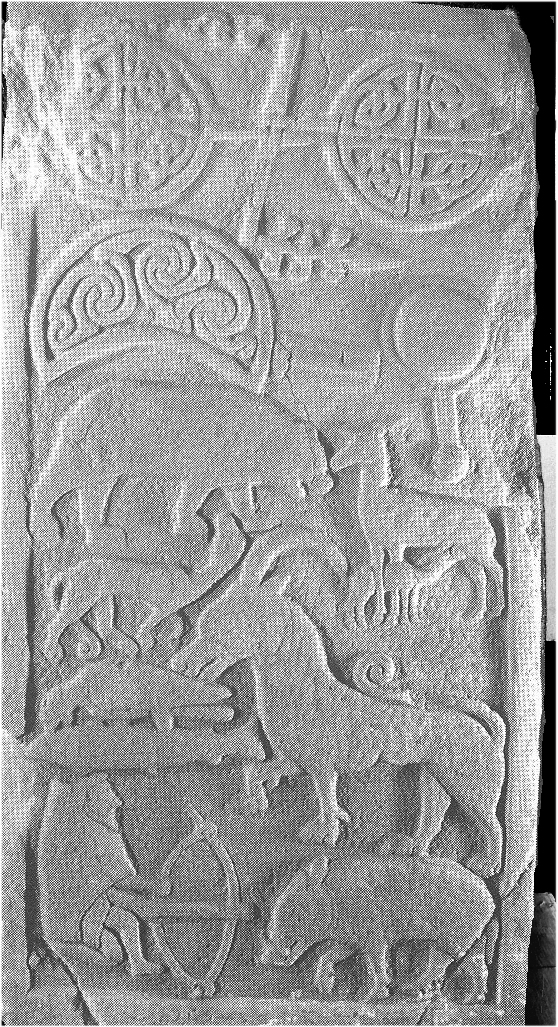 Drosten Stone (front)©Robert Hill |
This Celtic Pictish stone known as the Drosten Stone, which is found in the St. Vigeans museum in Scotland near Abroath and is dated to the 9th century, shows the symbols that appear at Gobekli including the boar, cat, vulture, dog, deer and bear. The boar appears on Celtic stones in the same way it appears at Gobekli Tepe. In the Dogon religion, the Mistress of Speech, (the Seventh Ancestor), was symbolized by the donu bird, the fish, serpent, ostrich, deer, or gazelle. The arrow which appears on this stone is associated with the hunt, which is a regeneration ritual in the Dogon religion. The Mistress of Speech (Seventh Ancestor) was the mistress of the hunt. I believe that the eagle was also a symbol of her in ancient religions.
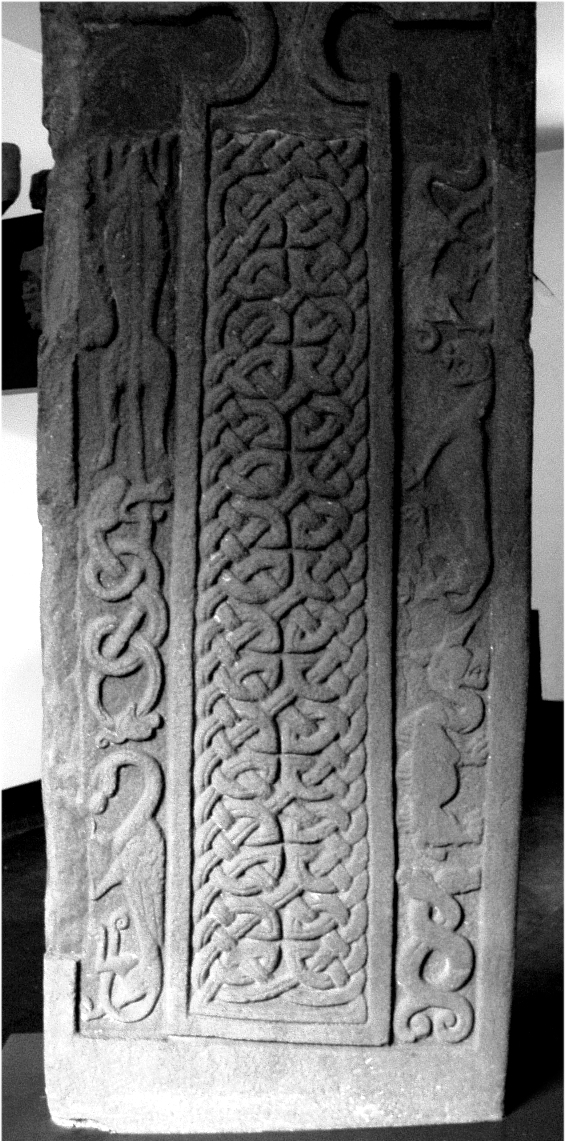 Drosten Stone(back)©Robert Hill |
The back of the stone shown above also reveals Dogon symbols. The dog, cat, dual serpents, fish, bird, eagle, goat, which was a symbol of the Jackal, and a dinosaur-like figure appear on this stone. The Celtic knotted image in the centre looks like a tunning fork.
According to the Dogon elder Ogotemmêli, the first humans had the ability to regenerate themselves and based on my research I would say that the temple at Gobekli Tepe had to do with regeneration. Many ancient temples associated with the process of regeneration appeared on hill tops and Gobekli Tepe is no exception. The name Gobekli Tepe means "Potbelly Hill".http://en.wikipedia.org/wiki/ G%C3%B6bekli_Tepe Others interpret Gobekli Tepe as meaning "navel mountain".http://medusacoils.blogspot.ca/2009/03/ worlds-first-Sheela-na-gig-at- worlds.html Lydia Ruyle
According to another Dogon account, when the Mistress of Speech was sacrificed and regenerated, she was hit by a lightning bolt that went into her spine, neck and kidneys. This lightning bolt came from the Nummo spaceship in the sky overhead. Dogon women used to wear a leather and metal strap to show the place where the sun (the spaceship) struck the Mistress of Speech's forehead. I believe that it is because of this that lightning became associated with many ancient regenerative myths referred to in Day of the Fish. It may be one of the reasons why these temples were built on hilltops like at Gobekli Tepe.Dorey, Day of the Fish pp.202-207
Another reason is that when they were parked underground, the spaceships created a large mound or hill when viewed from the outside. Because the Nummo were amphibians and they needed to keep moist in order to stay alive, the ships were also parked underwater or in caves.
When the ships were buried underground, the ancestors entered the ship mound through an opening in the top. The regeneration of humans was thus perceived as taking place in the Earth's womb. If we could look at the location from above ground, it must have resembled an anthill because the Dogon identified the place of regeneration with an anthill.Dorey, Day of the Fish pp.184-194 An image of an ant likewise appears at Gobekli Tepe. This association of regeneration with underground locations is apparent in other places of the world including Ireland. This is referred to in more detail in my book, Day of the Fish.Dorey, Day of the Fish p. 211
The Dogon religion, which was recorded by the French anthropologists Marcel Griaule and Germainne Dieterlen in the 1930s and 40s, was still a living oral culture when it was recorded. The meaning of these symbols, which were lost in other places of the world, were still being used by the Dogon. It is through the Dogon that we can decipher these symbols and understand the information that is being presented.
For more information on the Dogon religion refer to my books, The Master (Mistress) of Speech, The Nummo, Day of the Fish and The Rose.